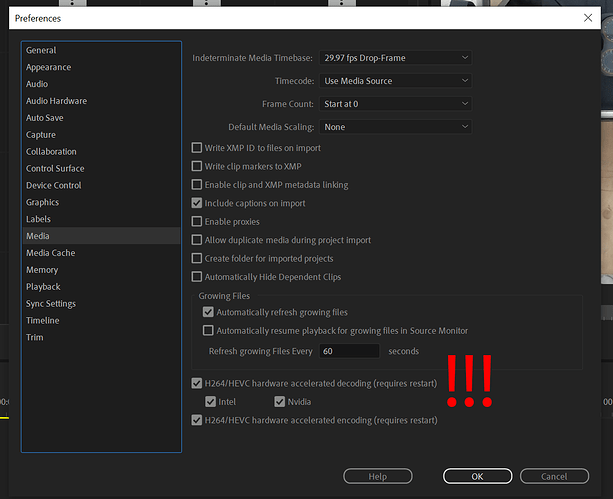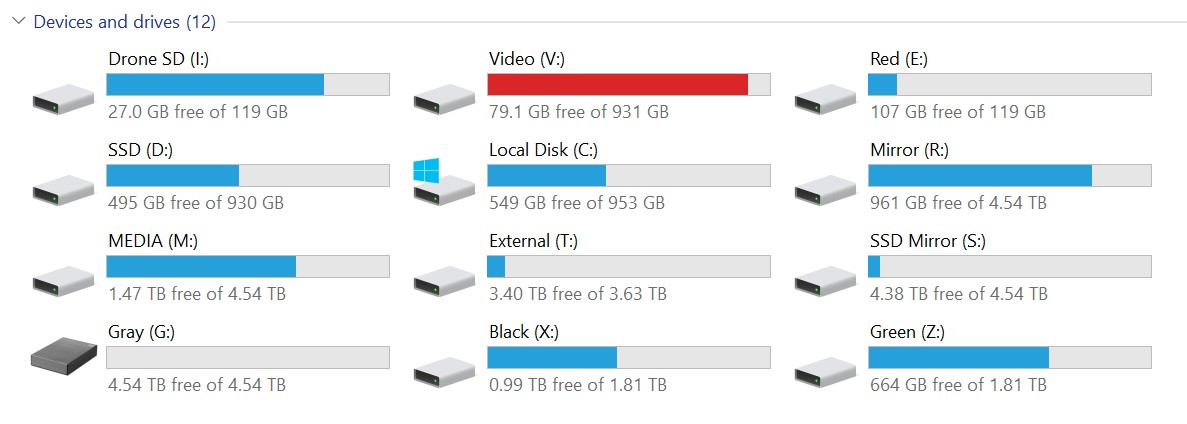Since starting this project, I’ve undergone the very painful process of trying to edit video with off-grid power system requirements most people don’t have to deal with. It’s been crazy frustrating, and I’ve reached a point where I believe there’s some light at the end of the tunnel.
And let’s get one thing out of the way. I realize the discussion that follows has nothing to do with building the Ultimate Adobe Premiere Workstation in 2021. It’s about the process of form following function within a set of constraints. It’s easy to throw a bunch of cash at Ryzen cores, GPUs, and 1KW power supplies if you have a healthy budget and are plugging into grid power. I get it. This is a different conversation. This is about bootstrapping an off-grid life with a DIY power grid.
Coming from a 2013 era laptop, I couldn’t really get Adobe Premiere to function in a usable way. The system was only upgradeable to 8GB of RAM, and the build-in GPU wasn’t up to the task. I did attempt to use it, but the only real upgrade available was swapping out the HDD for a SATA SSD. So I splurged and bought a Samsung 1TB SSD. I think that was their 850 Series. That actually helped tremendously, but didn’t get me where I needed to be. I added another Samsung SATA 1TB SSD, this time the 860 series. It wouldn’t be precise to say that Premiere runs smoothly with one drive for OS/apps, and another for caching. My experience is more that 2 drives is a bare minimum. So with that old laptop upgraded as much as possible, and still failing, I jumped back into the desktop world.
My initial purchase, and what I’ve been using for over a year now, was the HP Slimline 290-p0043w. This system has a bit of a cult following online because of its high performance relative to price, coupled with low energy requirements. The most popular configuration from the factory comes with:
Intel Celeron G4900 (Coffee Lake-S)
-
CPU speed: 3.1 GHz base frequency -
CPU cores: 2 -
CPU Cache: 2 MB -
TDP: 54 W -
Integrated graphics: Intel UHD Graphics 610
I picked one up on eBay for around $100. The base model has 4GB of RAM, and the one upgrade I did was pulling the 4GB stick and adding 2x 16GB sticks for a total of 32GB of RAM.
At that point, Premiere was functioning, and while the editing experience was slow, and required proxy generation, it was workable – sort of. In addition to the lack of snappiness even with proxies, proxy generation time was roughly 2x-4x playback time. In other words, a 1 minute clip would take 2-4 minutes to render into a proxy. No bueno.
The bigger problem, as I quickly learned, was that the GPU and Premiere wouldn’t play well together. I experienced frequent BSODs (blue screen of death!), lost tons of work, and nearly checked myself into the nearest insane asylum.
Another upgrade the 290 allowed was an NVME drive. Adding a Samsung 960 for the boot drive, then using the Samsung 860 as the media drive, did boost performance noticeably. Because tests by Puget Systems showed a 3-drive configuration to be optimal, I also added a 128GB SATA drive and dedicated it to media cache in Premiere, Media Center, et cetera. This did speed up the workflow, but didn’t stop the system from crashing regularly.
While somewhat of a tangential problem, let’s linger on the topic of drives for a moment. The HP 290 has 2 SATA ports and supports one NVME drive. It also has 4x USB 3.0 ports. The problem with this combination is that there’s no clean way to run slower/cheaper HDD drives in a RAID configuration, as most RAID controllers won’t do RAID over USB. In a video editing use-case, this does present potential storage problems. I did experience a number of storage issues, and ended up adding a PCI expansion board with 4 more SATA ports. That resolved some of the workflow problems that come along with video editing, but since those were less of a problem than the crashing, I’ll move along.
Since the CPU and GPU are coupled together on that platform, and there was a clear bottleneck there, I did the last speed upgrade available. This was upgrading the CPU to the most recent Intel processor the motherboard would handle. Since energy consumption remained a huge limitation, I went with a Core i5-9400. Again, this was an eBay purchase for about $100. I think the motherboard might be able to handle the Core i9-9900, but going past the i5 quickly results in increased power consumption. the i5 has the same advertised TDP as the lowly Celeron at 54W. The i9 is advertised at 65W, which doesn’t sound like much, but others reported significant differences in power consumption at idle. With the Celeron and i5, I was bouncing in the 15-20W range of energy use at idle – a number I was happy with.
Unfortunately, the processor upgrade didn’t solve the BSOD problems. It turned out that part of the issue had something to do with the drivers in the built-in 630 Intel graphics and Adobe Premiere. Every time drivers would come out, I’d get a prompt, and promptly upgrade. Every time the BSODs persisted. The only drivers which were useful were a narrow window of versions from around October and November of 2020. As luck would have it, that’s when I first started editing videos for TikTok and Youtube, so I got in at the peak of the GPUs effectiveness. Alas, it went downhill from there.
Now, the reasonable upgrade in a video editing situation would be to add a PCI GPU. While this was technically possible, the case for the 290 would only accept low-profile video cards. That upgrade still probably would have helped, but there’s another idiosyncratic issue with that motherboard. Unlike most standardized versions of the various flavors of ATX/ITX motherboards, the proprietary HP Menlo board has a hobbled bios. For my application the only thing that really mattered was that it wasn’t possible to utilize the on-board GPU and a PCI GPU simultaneously. Perhaps I’ll get into the issues surrounding NVENC, Quick Sync, and the various levels of hardware acceleration in Premiere at some point, but for now let’s just say that it’s better to have all of the above working at once. Well, the HP motherboard forces one to choose one or the other. In a system this limited, being forced to disable useful hardware was a bad idea. That lead me to bite the bullet and make the upgrade which brings us to the current moment.
Due to budgetary and energy consumption restraints, I chose to stay in the same family of CPUs, and upgrade to a motherboard which had more upgrade options. I ended up deciding on the Z390 platform, and ultimately purchasing a Gigabyte AORUS PRO WIFI Z390. As is the theme, this was another eBay purchase for about $100. This motherboard has a BIOS which allows utilizing the Intel 630 graphics on the i5-9400 at the same time as whatever combination of GPUs installed in the 3 full-size PCI slots.
If you haven’t been in the market for video cards lately, it’s a madhouse. Cryptocurrency miners have very similar requirements as I do, and demand from them has driven prices up. It’s still at the point where used 3-year old cards are more expensive than they were originally. I won’t dwell on that too long other than to say this forced me to diverge from my habit of $100 eBay upgrades.
After about 6 weeks of the most stressful eBay bidding I’ve gone through (and I buy things on eBay A LOT), I ended up getting an Nvidia Quadro P1000 card for just under $200. Through some combination of patience and luck, this was actually the lowest price I’d seen one go for in that timeframe. Others were going for as high as $280, and the Buy-it-now prices were regularly over $300.
As I type this, I can’t express how ecstatic this screen makes me! Pay special attention to the bottom left corner. Two GPUs at the same time!!!
And not only that, the Media Panel in Adobe Premiere agrees!
Intel and Nvidia hardware acceleration working at the same time!!!
I still have a bunch of tweaking to do. At this point, the system is idling at about 50W, which is well above my target range of 20-30W. When I’m working when there isn’t direct sunlight on the solar panels, a 50W idle only gives me about 2.5 hours of runtime on my DeWalt power bank with the computer, satellite internet, 4k main monitor and 1080p preview monitor all going at the same time. One of the remaining housekeeping tasks is sorting out the drives. I’m super happy that I’m able to get all of them running at once. So one more screenshot and I’ll wrap this up:
That’s about 31 TB of data capacity on a mix of SSD and spinning drives. At the moment, none are set up in a RAID configuration, and I don’t think Windows is sleeping the drives at all. The HDDs are mostly for archival storage, and are needlessly sucking up power. So once that gets dialed in, I’ll have a better idea of how much juice the system is really using. Additionally, I don’t have enough mini-DP cords to run both displays off of the Nvidia card. So the Intel GPU has to stay active all the time to support extending the Windows desktop to the second monitor. I’m hoping migrating that to the Quadro P1000 will drop the idle utilization a watt or two. We shall see!
I have started editing again in Premiere. Since I just finished this build, I haven’t finished any projects yet. That said, the experience so far has been night and day difference with the new motherboard and graphics card. Knock on wood, but no BSODs so far.
And yes, this is a long way of saying that I’ll finally be releasing new videos soon. Most of the terrabytes filling up those drives are made up of hours and hours of footage I’ve shot in the last year, but haven’t been produced yet.




